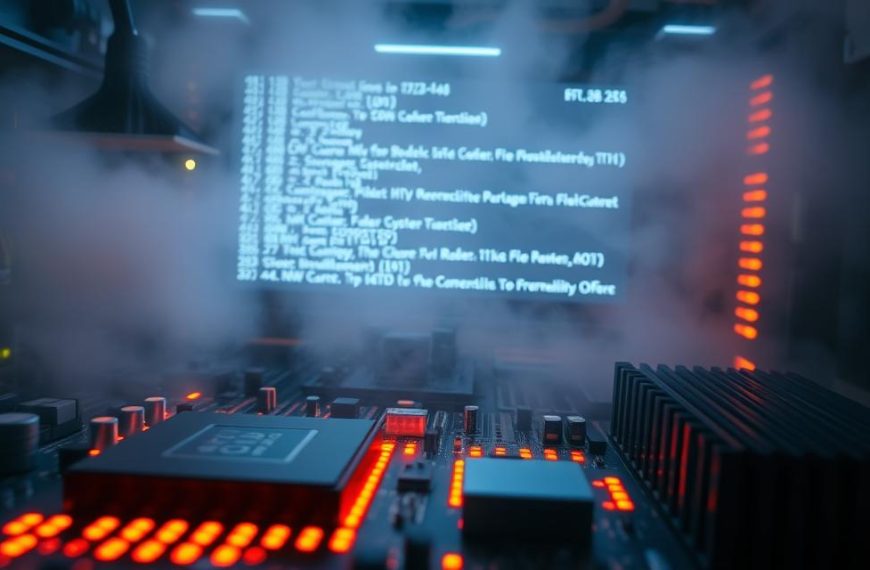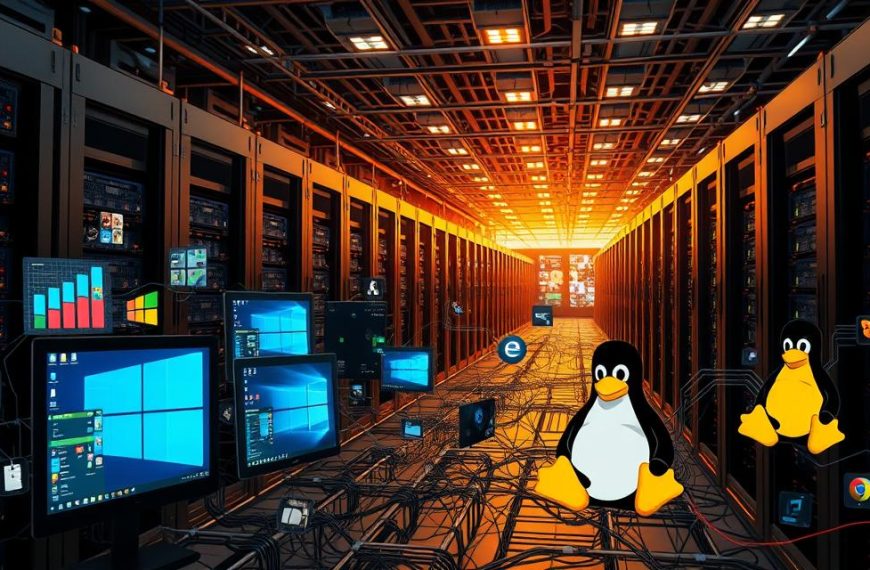Computer hardware is changing fast, thanks to amazing tech breakthroughs. New tech is quickly reshaping our future1. Nanotechnology is key, making computers faster, smaller, and more portable1.
Advanced tech is pushing computer hardware to new heights. Artificial intelligence and machine learning are changing how hardware works1. They focus on making computers perform better and use less energy.
Future tech includes super-fast processors and energy-saving storage devices. It also features highly sensitive sensors1. These use new materials and nanotechnology to create better computing solutions.
Smart hardware is growing in homes, factories, and hospitals. This growth means hardware must work well together1. It also needs to be secure and use energy wisely.
New tech is changing how we use digital systems. Face recognition, augmented reality, and virtual reality are getting more popular1. This shows a trend towards more connected and immersive hardware.
What are the current trends in computer hardware platforms?
Computer hardware is evolving rapidly. Innovative processor designs, advanced memory tech, and energy-efficient solutions are driving this change. These advances are reshaping our view of computational performance and efficiency2.
Advanced Processor Architectures
Modern processors are embracing revolutionary designs. Heterogeneous computing systems are emerging as a game-changer. They integrate various processor types to optimise performance across different applications3.
Chiplet architecture is a significant breakthrough. It offers unmatched flexibility and scalability in processor design.
- Multicore processors with enhanced performance capabilities
- Integrated processor designs for improved efficiency
- Specialised computing units for specific computational tasks
Memory and Storage Innovations
Persistent memory tech is changing data storage norms. Intel Optane and next-gen solid-state drives are pushing storage performance limits2. SSD storage on graphics cards is becoming crucial for high-performance computing3.
Energy-Efficient Computing Solutions
Energy efficiency is now vital in computer hardware development. Dynamic voltage and frequency scaling help extend battery life and reduce environmental impact3. Companies are adopting hybrid computing models to balance performance with power use3.
“The future of computing lies in intelligent, energy-conscious hardware design”
These trends show the ongoing evolution of computer hardware platforms. They promise more powerful, efficient, and sustainable computing solutions. Both businesses and consumers stand to benefit from these advancements2.
Artificial Intelligence and Machine Learning Hardware
AI hardware is evolving rapidly, driven by innovations in machine learning accelerators. The semiconductor market is set to reach $300 billion by 2025. AI and machine learning are leading this growth4.
Edge AI enables intelligent processing directly on devices. Modern AI hardware includes specialised components for complex computational tasks. These components include:
- Tensor Processing Units (TPUs)
- Neural Processing Units (NPUs)
- Advanced GPU configurations
AI applications require substantial computational power. Training an autonomous driving model needs over 140 servers for 97% accuracy4. Hardware must keep up with sophisticated machine learning workloads.
| AI Hardware Component | Key Performance Characteristic |
|---|---|
| NPUs | Optimised for neural network computations |
| GPUs | Parallel processing capabilities |
| Specialised AI Chips | Energy-efficient AI acceleration |
AI PCs are predicted to make up 60% of shipped computers by 20275. Microsoft and Apple are adding AI chipsets to boost performance on personal devices5.
The future of computing lies in intelligent, specialised hardware that can process complex AI algorithms with unprecedented efficiency.
Edge AI is advancing rapidly. We can expect more breakthroughs in machine learning accelerators. These advances will push the limits of computational intelligence6.
Quantum Computing and Neuromorphic Processing
Quantum computing and neuromorphic processing are reshaping computer hardware. These technologies challenge traditional computing methods. They promise to redefine computational capabilities7.
Quantum computing represents a massive leap in technological innovation. The global market is set to grow dramatically7. It uses quantum principles like superposition for faster information processing7.
Quantum Computing Breakthroughs
Quantum computers are set to revolutionise multiple sectors, including:
- Pharmaceutical research8
- Financial portfolio optimisation8
- Molecular property prediction in chemistry8
Brain-Inspired Computing Systems
Neuromorphic processing copies biological neural networks. It creates brain-inspired computing systems that work with amazing efficiency9. These systems boost pattern recognition and decision-making across various fields8.
Future Applications and Potential
Combining quantum computing and neuromorphic tech could unlock incredible computational power9. These advances could transform healthcare, transport, and AI. They offer solutions to complex global issues9.
| Technology | Market Value (2023) | Projected Growth |
|---|---|---|
| Quantum Computing | USD 3 billion | USD 25 billion by 2028 |
| Neuromorphic Computing | Emerging Market | Rapid Development |
Edge Computing and IoT Integration
Edge computing and IoT integration are transforming data management. This shift brings computing closer to data sources, boosting efficiency and decision-making10. IoT devices are set to reach 18.8 billion by 2024, a 13% rise from the previous year10.
Edge computing changes data processing by enabling local storage and analysis. This cuts network traffic and latency, allowing quick information extraction11. Global edge computing spending is expected to hit £228 billion in 202410.
- Local data processing enhances real-time insights
- Reduced network congestion and improved efficiency
- Enhanced security through localised computing
Security remains a key concern in edge computing adoption. About 47% of North American respondents view data protection as a major hurdle10. Organisations must address these challenges while harnessing distributed computing’s potential11.
The IoT landscape continues to grow rapidly. Forecasts predict 46 billion edge-enabled IoT devices by 2024. This number could reach 77 billion by 203010.
Sustainable and Green Computing Technologies
The digital revolution is driving a critical shift towards sustainable computing. Our digital infrastructure’s environmental impact is becoming increasingly significant. IT currently generates 2-3% of global CO2 emissions, potentially rising to 8% by 202512.
Green technology is revolutionising computing approaches. It focuses on reducing environmental footprints and creating energy-efficient solutions. Companies now recognise the importance of sustainable computing practices13.
Energy-Efficient Data Centres
Data centres lead sustainable computing efforts. Computer centres’ electricity use may account for over 14% of global emissions by 204012. Organisations are implementing innovative strategies to combat this issue.
- Utilizing renewable energy sources13
- Implementing advanced cooling systems13
- Deploying smart monitoring technologies13
Recyclable Components
Sustainable computing extends to hardware development. In 2018, IONOS reduced CO2 emissions through hardware recycling12. The industry now focuses on eco-friendly solutions.
- Developing biodegradable electronic components
- Creating more easily recyclable hardware
- Implementing circular economy principles
Carbon-Neutral Computing
Carbon-neutral computing is becoming more achievable. Businesses can reduce their environmental impact using cloud hosting and energy-saving practices12. The Energy Star program promotes energy-efficient computing hardware13.
Emerging Display and Interface Technologies
Advanced displays are changing how we interact with digital tech. User interfaces are evolving rapidly, with immersive tech pushing visual and interactive boundaries. VR and AR have become more sophisticated, enabling realistic interactions across various sectors14.
Innovative display tech is transforming digital experiences. Silicon Motion’s new USB display interface showcases cutting-edge screen developments. These advancements support multiple high-res displays, offering seamless connectivity for professionals and creatives15.
Interface tech is expanding beyond traditional screens. Haptic feedback and gesture recognition create more intuitive interactions. Brain-computer interfaces promise to redefine human-digital communication14.
These technologies have potential in gaming, education, healthcare, and industry. As they develop, we can expect more transformative user experiences. The future lies in creating natural, responsive ways to interact with digital environments15.
FAQ
What are the most significant trends in computer hardware right now?
How are AI hardware developments changing technology?
What is quantum computing, and why is it important?
What is edge computing, and how does it work?
How are computer hardware manufacturers addressing sustainability?
What emerging interface technologies are transforming user experiences?
What are neuromorphic processing systems?
How are memory and storage technologies evolving?
Source Links
- https://www.deepseadev.com/en/blog/future-of-hardware-and-trends/
- https://www.startus-insights.com/innovators-guide/whats-currently-happening-in-computer-hardware/
- https://phantran.net/what-are-the-current-trends-in-computer-hardware-platforms/
- https://www.tooli.qa/insights/ai-hardware-key-components-market-growth-and-future-trends
- https://securityintelligence.com/articles/trends-hardware-gets-ai-updates-2024/
- https://www.pugetsystems.com/solutions/ai-and-hpc-workstations/machine-learning-ai/hardware-recommendations/?srsltid=AfmBOopdf_mvZJDFqbWkWqbHxGgcSHAFo51ZbuAGrCPemUWidKqtqU_A
- https://www.rolandberger.com/en/Insights/Publications/Quantum-computing-and-AI-A-superpower-in-the-making.html
- https://www.fingent.com/blog/quantum-vs-neuromorphic-computing-what-will-the-future-of-ai-look-like/
- https://quantumzeitgeist.com/quantum-computing-and-neuromorphic-computing-comparing-future-technologies/
- https://www.techtarget.com/searchcio/tip/Top-edge-computing-trends-to-watch-in-2020
- https://www.run.ai/guides/edge-computing/edge-computing-in-iot
- https://www.ionos.co.uk/digitalguide/hosting/technical-matters/green-computing/
- https://www.techtarget.com/searchdatacenter/definition/green-computing
- https://www.pwc.com/us/en/tech-effect/emerging-tech/essential-eight-technologies.html
- https://www.forbes.com/sites/bernardmarr/2022/11/21/the-top-10-tech-trends-in-2023-everyone-must-be-ready-for/












